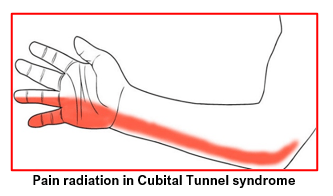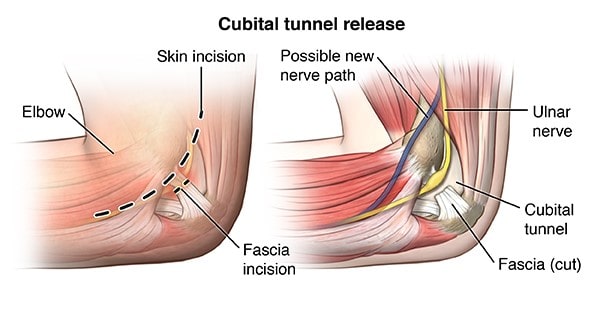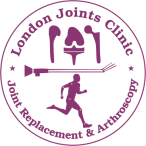Cubital Tunnel Syndrome
Cubital Tunnel Syndrome is a condition characterized by compression of the ulnar nerve in an area of the elbow called the cubital tunnel.
The ulnar nerve travels down the back of the elbow behind the bony bump called the medial epicondyle, and through a passageway called the cubital tunnel. The cubital tunnel is a narrow passageway on the inside of the elbow formed by bone, muscle, and ligaments with the ulnar nerve passing through its centre. The roof of the cubital tunnel is covered with a soft tissue called fascia.
When the elbow is flexed (bent), the ulnar nerve can stretch and catch on the bony bump. When the ulnar nerve is compressed or entrapped, the nerve can tear and become inflamed leading to a variety of symptoms, called cubital tunnel syndrome.
The common causes for cubital tunnel syndrome are:
- Trauma
- Repetitive motion
- Frequent pressure on the elbow for extended periods due to sitting posture
- Pathologies such as bone spurs, ganglion cysts, or tumours in the cubital tunnel leading to pressure and irritation of the ulnar nerve.
Cubital tunnel syndrome is diagnosed based on patient’s typical medical history, thorough clinical examination and appropriate investigations to confirm ulnar nerve compression.
In general, signs and symptoms of Cubital Tunnel Syndrome arise gradually, progressing to the point where the patient seeks medical attention. Commonly reported symptoms associated with cubital tunnel syndrome include:
- Intermittent numbness, tingling, and pain in the little finger, ring finger, and the inside of the hand. These symptoms occur more frequently at night, and with elbow bending or prolonged resting on the elbow.
- Aching pain to the inside of the elbow
- Weakness in hand with diminished grip strength
- Reduced sensation and fine motor control in the hand causing the person to drop objects or have difficulty in handling small objects.
- Muscle wasting in the hand and permanent nerve damage, if left untreated.

Elbow X-rays and electro diagnostic tests such as electromyography (EMG) and nerve conduction studies (NCS) are advised. X-rays may show bony lesions near the medial epicondyle.
EMG and NCS tests assist in confirming the compression of the ulnar nerve, determining how well the nerve is functioning and locating areas of muscle wasting and nerve compression.
The severity of nerve compression gets graded as mild, moderate or severe.
Cubital tunnel syndrome can be treated with conservative and surgical methods.
Generally conservative treatment options are recommended initially to treat the symptoms unless muscle wasting, or nerve damage is present.
Conservative treatment options may include:
- Avoid frequent bending of the elbow.
- Avoid pressure on the elbow by not leaning on it.
- Elbow pads may be worn to decrease pressure when working at a desk.
- Wear a brace or splint at night while sleeping to keep the elbow in a straight position. You can also wrap the arm loosely with a towel and apply tape to hold in place.
- Avoid activities that tend to bring on the symptoms.
- Anti-inflammatory medications may be ordered to reduce swelling.
- Physiotherapy is started as tolerated for stretching exercises, strengthening of muscles, and improving elbow mobility.
If conservative treatment options fail to resolve the condition or if muscle wasting or severe nerve compression is already present, then your surgeon may recommend a surgical procedure to treat your condition.
The aim of Cubital Tunnel surgery is to reduce the pressure on the ulnar nerve by providing more space for the nerve to move freely and to increase blood flow to promote healing of the ulnar nerve. There are different surgeries that can be performed such as:
Medial Epicondylectomy: This surgery involves removing the medial epicondyle, the bony bump on the inside of the elbow, enabling the ulnar nerve to glide smoothly when the elbow is flexed and straightened. Rarely needed
Ulnar Nerve Decompression +/- Anterior Transposition: This commonly performed surgery involves decompressing the ulnar nerve by cutting a fibrous tissue covering the roof of the cubital tunnel. This prevents the nerve from getting compressed with elbow flexion and extension.
If after release the nerve is found to be unstable or severely compressed, then it is moved to the front of the elbow and relocated in a new created tunnel in front of the medial epicondyle. This is called as ulnar nerve transposition.
Dr Jadhav will decide which options are best for you depending on your specific circumstances.
After your surgery, you will be given some guidelines and instructions. These are to be followed, depending on the type of repair performed and the surgeon’s preference.
Common post-operative guidelines include:
- A bulky dressing with a plaster splint is usually applied following surgery for 10-14 days.
- Elevating the arm above heart level and moving the fingers are important to prevent swelling.
- The arm dressing is removed after 10-14 days for removal of the sutures.
- Elbow immobilization for 3 weeks after surgery is usually indicated, longer depending on the repair performed.
- Ice packs are applied to the surgical area to reduce swelling. Ice packs in its cloth cushion should be applied to the affected area for 20 minutes 4 to 5 times a day.
- The surgical wound is kept clean and dry. Cover this area with plastic wrap when bathing or showering.
- Physiotherapy is started for elbow mobilisation and strengthening after a few weeks after surgery. These elbow and hand stretching exercises help in strengthening muscles, improving mobility and maximising the use of hand and forearm.
The majority of patients suffer no complications following cubital tunnel surgery. But some risks and complications, can occur following elbow surgery.
These may be:
- Swelling around elbow, forearm or hand
- Infection
- Nerve damage causing permanent numbness around the elbow or forearm.
- Elbow instability
- Elbow stiffness or flexion contracture
- Pain at site of scar
- Persistence of symptoms even after the elbow surgery.
Book An Appointment
Private Clinics : Locations & Directions
London Joints Clinic (Pune)
Address
Office S 5, 2nd Floor, North Block, Sacred World Mall,
Opp Sacred Heart Township, Near Jagtap Chowk,
Wanawadi, Pune 411040
Monday to Saturday
6 PM to 9 PM
Appointments
Hospitals OPDs : Locations & Directions
Jupiter Hospital (Baner)

Address
Lane 3, Baner- Balewadi Road,
Prathamesh Park,
Baner, Pune 411 045
Monday to Saturday 11 AM to 4 PM
Appointments
Contact us
Dr Anand Jadhav has a centralised appointment system for all locations across various hospitals and clinics in Pune & PCMC areas
Appointment Bookings & Requests can be made by any method :

